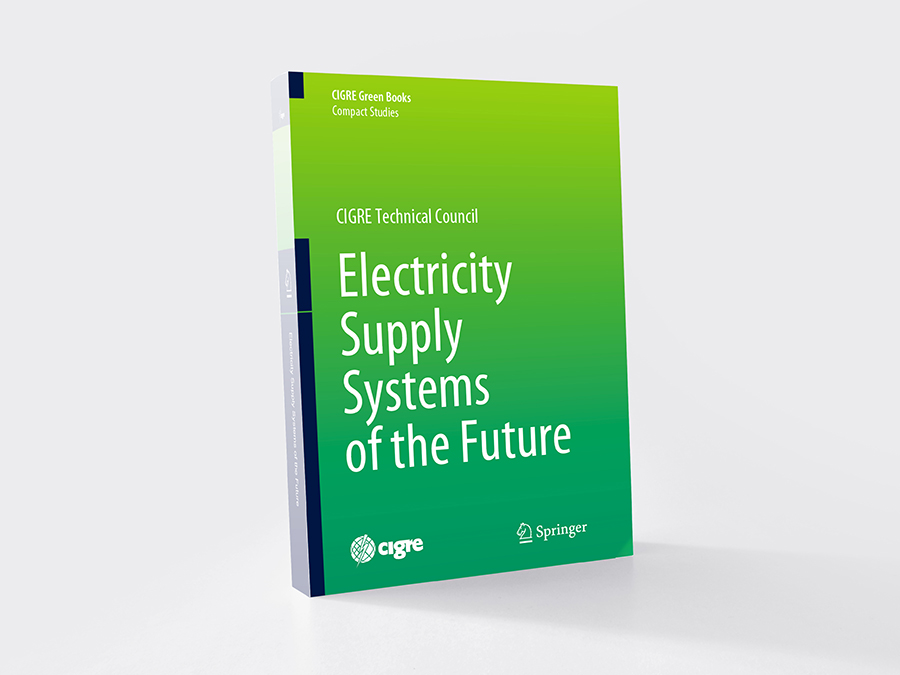Power system development and economics
by Konstantin Staschus, Chair, & Peter Roddy, Secretary
The Paris Agreement and climate neutrality goals for about the year 2050 are driving energy transition planning in most countries worldwide. Renewable energy-dominated 2050 power systems which serve e-mobility, heat pump and electrified industrial loads much higher than today, are becoming routine study subjects in planning already today. Therefore power system planning, investment analysis and asset management, i.e. the Study Committee (SC) C1 scope, are at the heart of planning for and managing this enormous transition that the entire world must go through together, at the same time, with the same goals and challenges. As one example, because of this common global climate and energy transition challenge, cooperation in a global electricity network seems increasingly realistic and appropriate, and SC C1 is refining its highly successful first neutral global grid feasibility study in a follow-up Working Group (WG).
As all other SCs, SC C1 has described the role of system development and economics in the new CIGRE Green Book future “Electricity Supply Systems of the Future”. Uncertainties play a key role in planning for 2050 climate neutrality, concerning future cost reductions in photovoltaics, onshore and offshore wind energy, electric vehicles, batteries, electrolyzers, UHV transmission technology, EHV cables, converters etc. However, the world’s climate neutrality goal makes power system planning under uncertainty easier in one particular respect: Whatever scenarios we analyse and however strongly they diverge from each other over coming decades, the goal remains a climate-neutral energy system by mid-century. At least with respect to greenhouse gas emissions, the scenarios need to converge by about 2050 towards zero, even if the exact mix of locally and globally traded electricity, of electric vs. hydrogen-based transport, of thermal or hydrogen-based seasonal storage, of nuclear vs. renewable generation will differ by scenario.
The mission and 2019 progress of SC C1 is very much in line with this important role of power system development & economics for the world’s climate neutrality goals, i.e. to support electricity system planners and asset managers worldwide in anticipating and successfully managing system changes to address emerging needs, opportunities and uncertainties while respecting multiple constraints. SC C1 aims to provide particularly strong value with its recommendations on methods and descriptions of practices during the ongoing electricity system paradigm shift, brought about by the December 2015 Paris Agreement for climate protection, the swift introduction of CO2-free renewable energy sources aided by rapid evolution in generation patterns and economics, and also by digitalisation, demand response, and in social, environmental and regulatory frameworks and expectations.
The unique perspective of SC C1 is to show how this paradigm shift can be managed while emphasizing the integrative role of the transmission and distribution networks for the entire system which also includes generation and demand. The system needs to be: planned to deal with the changes; built taking into account economic and public acceptance challenges; and well maintained. Making the most of the change implies supporting customers’ and market participants’ desire to implement innovative solutions and emphasizing opportunities – along with risks – which the changes bring. It also implies anticipating, integrating and supporting progress. Opportunities for improvement relate to e.g. customer empowerment, increased penetration of distributed generation, closer transmission-distribution cooperation, new technologies, and efficiency and sustainability improvements.
The scope of SC C1 work generally includes descriptions of state-of-the-art applied methods and practices for system planning, economics and asset management. To provide value to SC C1’s target audience, the drivers of the ongoing paradigm shift need to also partly drive the methods and practices that SC C1 recommends: smart grids and demand-side response; energy-efficient electrification of heating and transport; generation cost structure changes, especially for renewable and variable distributed generation; energy storage and sector coupling options; sustainability policies (e.g. CO2), as well as evolving regulation; and electricity market development and integration.
The four main areas covered by SC C1 are:
- System planning
- Asset management
- Business management
- Interconnections – horizontal, vertical
The main sections of this Annual Report describe how the SC and its Working Groups (WGs) have addressed in 2019 the effects and the management of the paradigm shifts in each area.
The 2019 annual SC C1 meeting was held on 26 September 2019 during the Chengdu Symposium in China and was attended by 21 members and observers. The symposium attracted 336 participants from 30 countries and was co-organized by SCs B3, B5, C1, C3, C6 and D2. SC C1 also supported the Aalborg Symposium in Denmark which attracted 325 participants from over 30 countries and was co-organized by SCs B1, B2, B4, C1, C2, C3, C4 and C6.
SC C1 tutorials were held during the Aalborg Symposium (on the future of reliability by Keith Bell/UK and Jeff Palermo/US) and the Chengdu Symposium (on optimal power system planning under growing uncertainty by Ning Zhang/CN and on feasibility study of a global electricity network by Gerald Sanchis/FR). Webinars were held on 14 March 2019 on “Global Electricity Network Feasibility Study” by Gerald Sanchis, and on 13 June 2019 on “ISO 55001 Asset Management Implementation Guidelines and Case Studies” by Boudewijn Neijens/CA.
During 2019 SC C1 published Technical Brochures on ‘Global electricity network feasibility study’, ' New investment decision processes and regulatory practices required to deal with changing economic drivers’, and ‘ISO Series 55000 Standards: General Process Assessment Steps and Information Requirements for Utilities’. Consistent with our system planning-related mission, the SC C1 Chair Konstantin Staschus contributed in leading roles to the CIGRE Technical Council joint WG with the World Bank for disseminating CIGRE results and creating CIGRE structures in Africa.

The Green Book is available for purchase on our partner's website Springer.
If you are a CIGRE Member, please contact us to benefit from a 40% discount on your purchase.
Strategic Plan
The C1 Strategic Plan was initially published in the Autumn of 2015 and was most recently updated in April 2019. The Strategic Plan covers the period to 2020 as the incoming SC Chair in August 2020 will wish to map out his strategy.
Reports issued in 2019
TB 775 – This TB on the global electricity network (feasibility study) was published by WG C1.35. With the strong development of renewable energy sources worldwide, the concept of a global electricity network has been imagined in order to take advantage of the diversity from different time zones, seasons, load patterns and the intermittency of the generation, thus supporting a balanced coordination of power supply of all interconnected countries. The TB presents the results of the feasibility study performed by WG C1.35. It addresses the challenges, benefits and issues of uneven distribution of energy resources across the world. The time horizon selected is 2050. The study finds significant potential benefits of a global interconnection, identifies the most promising links, and includes sensitivity analyses to different factors, such as wind energy capacity factors or technology costs. A webinar was delivered in March 2019 and has been recorded.
TB 786 – This TB on investment decisions in a changing and uncertain environment was published by WG C1.22. The “low carbon future” environment will significantly change the economic drivers of energy policies and, notably, grid investment schemes. Thus, investment decision processes need to evolve, which was reviewed by WG C1.22. The WG studied four themes: organization issues, market issues, economic issues, and institutional issues. It produced many interesting learning points about the consequences of the changing and uncertain environment that the transmission industry now has to face and also identified some topics for further discussion within SC C1.
TB 787 – This TB on ISO series 55000 standards: Implementation and information guidelines for utilities was published by WG C1.34. The TB brings much needed guidance to electrical utilities in its four sections: an overview of asset management; a clause-by clause review of ISO 55001 that offers an interpretation in the context of electrical utilities, lists potential artefacts that utilities could use to demonstrate compliance and highlights numerous examples submitted by utilities; a survey on the progress and intentions of utilities regarding ISO 55001; and finally three in-depth case studies listing the processes and IT systems put in place at utilities to address asset management needs. A webinar was delivered in June 2019 and has been recorded.
System Development
Overview
As highlighted in the overview, system development of a secure, sustainable and affordable power system has become central to the world’s climate neutrality goals. Planning methodologies and evaluation tools continue to evolve in order to live up to the enormous climate change challenge, the many associated uncertainties, but also the great opportunities and benefits which electrification can bring in both emerging and mature economies. Sector coupling with mobility, heating/cooling, smart cities, climate-neutral industries and hydrogen are becoming increasingly important to system planners and to SC C1. There are also institutional (e.g. transmission and distribution operator cooperation) and stakeholder involvement challenges that need to be overcome to deliver the network of the future.
Work in progress
JWG C1/C4.36 reviews large city & metropolitan area power system development trends taking into account new generation, grid and information technologies. Metropolitan areas are increasing in size, population, surface area, political and economic importance. The WG considers new technologies to replace ageing assets rather than replacing assets on a like-for-like basis. This will include cross industry coordination and cooperation considerations, taking into account power flows to and from the distribution network; application of innovative measurement devices; development of electric vehicles; active and reactive power flow control technologies and their increasing automation; economic drivers for large city & metropolitan area development; large scale HV and UHV cable route penetration; rooftop PV penetration etc. Criteria and principles for large cities power system operation and development will be proposed. The TB is scheduled for publication in 2020.
WG C1.39 describes the state of the art in optimal power system planning under growing uncertainty: Power systems are faced with unprecedented growing uncertainties coming from high penetration of renewables, electrification of transportation, heating and cooling, development of distributed energy, micro-grids, energy storage facilities, smart grid and policy and structural uncertainties. This WG examines how the traditional power system planning deterministic methodologies and fixed criteria remain applicable or need to be supplemented or replaced with new approaches. The WG seeks to understand the impact of uncertainty factors on the power system and the interrelationship among the various factors, these include generation planning with high share of renewable energy, risk-based transmission network planning, probabilistic planning criteria. A draft report has been reviewed by C1 and publication of the TB is imminent. This work was presented at a well-attended tutorial at the Chengdu Symposium in October 2019 was showcased at the 2020 e-Session in a joint workshop with C1/C6/Cired.37.
JWG C6/C1.42 addresses planning tools and methods for systems facing high levels of distributed energy resources. It identifies the impact of large deployments of distributed energy resources (DER) at the distribution level and repercussions on the transmission grid, as well as the tools, methods and benefits of aggregating DER at the distribution and transmission levels. The WG investigates the potential of co-simulation tools allowing the analysis of the impact of distribution-connected DER on the transmission grid considering static and dynamic aspects. It identifies and defines the planning and operation tools required at the distribution and at the transmission levels. The WG surveys distribution and transmission utilities for present practices and additional needs focusing on already known techniques, tools, methods and data for valuing DER and customer flexibility, practices and techniques in developing scenarios, both for transmission and for distribution (where e-mobility presents large uncertainties).
Business Investment
Overview
The work in this area addresses uncertainties and increasing penetration of renewable energy from the investment viewpoint. Business management involves investment decisions in all aspects of the system, incl. generation, transmission, distribution, storage, and demand with its flexibility. It complements system planning with broader analyses of whether and how investments can actually be made, and infrastructure built. More specifically, the work in this area describes how investment drivers and regulatory processes are changing, how to communicate with the many relevant stakeholders, and how transmission and distribution investments relate to each other.
Work in progress
WG C1.23 describes transmission investment decision points and trees, by defining target networks at the end of a specified planning period to meet all the necessary criteria and requirements. To account for uncertainty, multiple potential target networks can be generated which further require a number of decision trees. This WG established if and how target networks are being used, and if they are used to generate decision trees and key decision points. In particular, it investigated processes used to determine the timelines of the decision points in the different countries and the methods used. The WG is making a concerted effort to publish its TB in 2020 following a number of interruptions.
JWG C1/C6/37/CIRED describes optimal transmission and distribution investment decisions under growing uncertainty. Transmission and distribution investment decisions resulting from a planning process require new approaches to deal with growing uncertainties on many parameters incl. new market designs, high penetrations of renewable energy, demand growth and so on. The WG summarizes learnings from several prior SC C1 and C6 WGs. It is now investigating how transmission and distribution planning scenarios are consistently used to ensure holistic investment decisions are made by both TSOs and DSOs. This work will be showcased at the eSession in a joint workshop with C1.39. The TB is scheduled for publication in 2020.
WG C1.41 aims to close the gap in understanding between stakeholders and electrical energy specialists. With the development of DER, significant numbers of customers are becoming stakeholders in the electrical industry. here is a need to bridge the gap in understanding between the technical specialists and the various stakeholders that have a vested interest in the electricity product. his WG will examine the gap in understanding amongst the various stakeholders of the range of technical issues from a planning perspective related to the changing nature of the power system and how this has developed. It will review how stakeholders perceive this gap and what is being done across the world to improve the level of understanding, particularly of the non-technical stakeholders. The TB is scheduled for publication in Q4, 2020.
Interconnections - Horizontal & Vertical
Overview
This area of SC C1 work examines the increasing interdependence and integration faced by system developers, on top of the usual complexity already implicit in grid planning, which arises from the power grid being at the center of the energy transition towards the climate-neutral energy system, both as a fundamental enabler and as the most impacted element. The new dimensions of system development tackled in this C1 work area are:
- higher interconnection rates between countries and systems, up to continental level and eventually to a global grid (“horizontal” interconnections); besides the traditional hurdles of realizing large technical infrastructures, these cross-border links spanning several jurisdictions face further critical issues in different authorisation patterns and market regulations, assessing and allocating costs and benefits, negotiating partners’ and investors’ roles, and managing international implementation;
- increasing interdependence of transmission and distribution grids, which means that going beyond issues like DER, active distribution grids, radical modification of flow patterns, consumer empowerment, energy communities, planners need to look at the end-to-end electricity system, leading eventually up to a joint transmission and distribution grid planning process (“Vertical” integration); this requires also an organisational and cultural change, since one TSO interfaces often with several or many DSOs, who are themselves undergoing a deep process of modernising their practices on local system development and of evolving towards smart grid operation;
- starting integration with other energy systems (“Sector Coupling”): to achieve global climate change targets, electrification of transport, heating/cooling and industry, fed by CO2-free power generation is a very effective route; therefore several workstreams are starting, in order to assess and capture the benefits of a common planning and a synergistic operation of various energy carriers (including gases and hydrogen), exploiting their respective capacities and complementarities in storing and transporting bulk energy.
Work in progress
WG C1.33 investigates interface and allocation issues in multi-party and/or cross-jurisdiction interconnections: it addresses the origination and design phase of such projects, focusing on the specific issues arising from the different rules/practices/investors’ policies, to be considered at early stage for the sake of project success. The work analyses real cases to extract the drivers, rationale and criteria of such issues, as well as the solutions adopted; it also describes the business model designed for realising the interconnection project according to the specific needs, in order to infer useful guidelines for project of high complexity. The TB is scheduled for publication in 2020.
WG C1.40 describes planning coordination between system operators, TSOs and DSOs; framework, methods, allocation of costs and benefits. Through a detailed survey with more than 30 questions, it aims at describing the state-of-the-art and best practices of collaboration between TSOs and DSOs. The survey scrutinizes the aspects, data, and processes where cooperation is needed, and the reasons and modalities why cooperation occurs or not. In the current analysis phase, focus is on extracting useful insights and guidelines for setting up a structured cooperation process, and calling for institutional rules to be established on data exchange and process execution. The TB is scheduled for publication in 2020.
WG C1.44 builds on the highly successful work of WG C1.35’s global grid feasibility study, to analyse more deeply the impact of large and cheaper storage and the effect of demand response as further elements to be co-optimised together with investments in transmission and in generation, and to begin addressing the necessary trading rules for a global grid.
The SC C6-led JWG C6-C1.33 on multi-energy system interactions in the distribution grid studies the configurations, impacts and prospects of multi-energy systems that enable enhanced solutions for intelligent electricity systems, energy storages and demand side management with an increasing share of DER. The WG reviews technologies and systems that integrate multiple energy carriers: Power-to-Gas (P2G), including electrolyzers, fuels cells, hydrogen storage, injection into gas networks; Combined Heat and Power (CHP); Combined Cooling, Heat and Power (CCHP); Power-to-Heat (P2H), including electric boilers, heat pumps, thermal storage; Power-to-Vehicle (P2V); pumped and compressed air storages. The Technical Brochure will also report on architectures, use cases and tools for multi-energy system operation, planning and design.
Asset Management
Overview
The work in this area addresses emerging issues in asset management related to operational, tactical and strategic aspects, in a context of increasing sophistication of risk and economic modelling and increasing convergence of asset management and planning data and methods. At present there is 1 WG and also a team developing a CIGRE Green Book on Asset Management.
WG C1.43 deals with establishing requirements for asset management platforms that will allow integration of data/information from different sources, will have capability to process data using prescribed algorithms, and will generate the desired outputs.
The Green Book on Asset Management aims to present all the material related to past and present asset management methodologies and approaches in order to establish a set of references to be used going forward in refining existing or developing new asset management techniques in electric utilities in general. The Green Book is led by editorial team and has a number of contributors, including from other SCs, and is expected to include 10 chapters (400-500 pages in total). The target publication date is Q4 2020 or Q1 2021.

CIGRE active Working Groups / Call for experts
Technical Council
As all SC Chairs, SC C1 Chair Konstantin Staschus participates in the CIGRE Technical Council and contributes to TC projects. His recent especially strong contributions focus on the dissemination of CIGRE work products in Africa, for which he leads a TC WG based on a Memorandum of Understanding with the World Bank, where a list of applicable CIGRE products as well as CIGRE experts has been created, where the new Western African National Committee in CIGRE was founded and approved, and where good progress is made towards foundation of a new Eastern African National Committee. Under the guidance of Keith Bell from C1, the CIGRE policy of Tutorials has not only been updated but applied in the Paris Session and in Symposia.
e-Session 2020, Centennial Session 2021 and future work
The 2020 e-Session was successful for SC C1 as for all of CIGRE, thanks to the great support by the Central Office, the excellent co-operative coordination in the Technical Council led by Marcio Szechtman, the SC C1 coordination in the Strategic Advisory Group, the tireless work by SC C1 Secretary Peter Roddy, and the outstanding work by the three SC C1 Special Reporters Valdson Jesus/BR, Mattias Jonsson/SE and Severine Laurent/FR. At the end of the e-Session Konstantin Staschus was happy to pass the SC C1 chairmanship to Antonio Iliceto of Terna, Italy, who has led or contributed extraordinarily strongly to several SC C1 WGs and helped shape SC C1 progress through his membership in its Strategic Advisory Group. Konstantin thanks all SC C1 and WG members for their trust, support and important contributions over the past 6 years, and especially all WG chairs for their dedication and persistence to see the WG work through to successful conclusion. Special thanks to the Strategic Advisory Group members Keith Bell/UK, Antonio Iliceto/IT, Chongqing Kang/CN, Ronald Marais/ZA, Phil Southwell/AU, Yury Tsimberg/CA, for helping lead the SC through important and difficult times, and to the all-important SC Secretary Peter Roddy/UK!
During the virtual SC C1 meeting during the e-Session, a set of new WGs was agreed to address the most pressing questions in relation to system development and economics. Besides this, SC C1’s future work focuses on the Paris 2021 Centennial Session, the delayed Kyoto Symposium (early 2022), and the Paris 2022 Session for which preferential subjects were also determined at the C1 virtual meeting.
Future meetings and events
- Slovenia Symposium, June 2021 (no C1 co-organisation but including several topics of interest)
- Paris Centennial Session, August 2021 (incl. annual SC C1 meeting)
- Kyoto/Japan Symposium (now scheduled for April 2022)
- Paris Session, August 2022 (including annual SC C1 meeting)
- Cairns/Australia Symposium, 2023 (to be confirmed)


